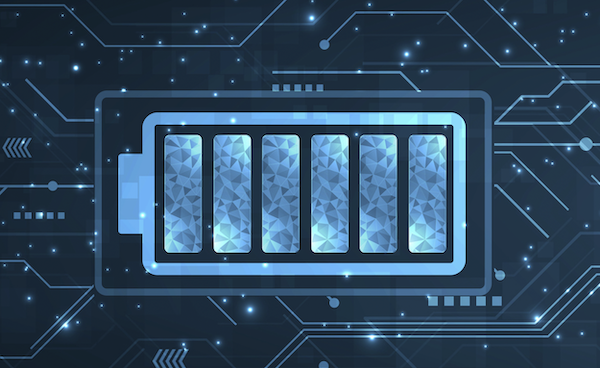Overview of the Problem and How to Lower Your Risk
Fires are Frequent Across a Wide Range of Products
It seems like there are battery fire incidents in the news every day. Recently, for example, an EV truck maker stopped production due to a battery fire in its plant, an airline flight was diverted due to an onboard battery fire (involving a passenger’s device), and numerous high rise building fires have been caused by electric bicycle batteries. Do a search on “lithium-ion battery fires” and you’ll see lots of dramatic results.
Batteries are part of our everyday life, and they’ll continue to proliferate in the future. This article will address battery fire causes and steps individuals can take to minimize personal risk.

Battery Construction
A basic battery has three components:
- An anode
- A cathode
- An electrolyte
There are all kinds of materials that can be used for these components. Common anode and cathode materials include graphite, nickel, manganese and oxides of cobalt. The electrolyte, which facilitates the flow of electrons via ion conductivity, can be lithium and a mixture of metal oxides or one of many other novel materials in development such as solid ceramic electrolyte and sodium ions.
Lithium gets lots of attention these days since it is a popular material in batteries present in your smartphone, laptop, e-bike and probably your electric vehicle (EV). And, of course, we like batteries that can be discharged to do some work and then charged up to do it again. Lithium-ion (Li-ion) batteries are good at that.
Energy Density
There was a time when the universe of battery types included primarily lead-acid, lead-zinc and alkaline. These are still used in a variety of applications, but their energy densities are not as good as Li-ion and other battery types.
Energy density is important for small portable devices like smartphones, since packing as much power as possible per unit weight makes for a light device. Packing as much power as possible per unit volume helps keep the device smaller.
When batteries are considered for EVs or power storage on the electric grid, energy density is important but other criteria become relevant, such as the number of discharge cycles before performance degradation. So, the growing, diverse market for batteries is driving a global quest for the best materials and optimized design.
Energy Density and Fires
If you short out or physically damage an old zinc-carbon “D” battery, not much happens. Do the same to a lithium-ion battery and you’ll have sparks and flames. Why? Because the energy density and oxidizing potential of the components in the Li-ion battery are much greater than those of the zinc-carbon battery.
Zinc-carbon batteries are simple devices. Li-ion batteries are complex to design and manufacture. This complexity introduces failure modes. An example of a Li-ion failure mode that can release a huge amount of energy very quickly involves formation of dendrites inside the battery. Dendrites are long, thin whiskers of lithium metal. If these form on the electrodes and penetrate the thin separator that sits between the positive and negative electrodes, a short circuit can occur and result in internal heating. The heat causes further internal damage, which leads to greater damage and more heat. This is a “thermal runaway” condition and it can cause a catastrophic event. (The FAA link at the end of this article has some dramatic video of this type of failure.)
Thermal runaway can also be caused by overcharging. An initial overcharge above a certain voltage causes damage inside the battery and subsequent overcharges can result in thermal runaway and a combustion event.
Since the energy release from a failure of a Li-ion battery is so great, various issues become important in preventing catastrophic events. These include:
- Manufacturing quality and testing
- Accurate control of charging and discharging (battery management)
- Protection from physical damage
- Proper use and handling throughout the entire battery life cycle
As consumers, we depend on product manufacturers to handle the first three bullets in this list. The last bullet is something over which we have control.
Safety from a Personal Perspective
You can take steps to protect yourself, your family and your property from battery fires. Here are some suggested actions:
- Only use battery powered devices and electronic or electrical appliances that have a third-party safety agency certification or listing. Safety agency examples include UL, CE, ETL, TUV SUD and GS. These entities and others set standards and test products for safety. (See the example product label below.)
- Nearly all devices need adequate ventilation when in use and when charging, so pay attention to what the product manufacturer recommends. Heat is an enemy of batteries and electronic equipment.
- When charging a product, keep it away from flammable objects. Example: charging a laptop on a kitchen countertop is safer than charging it while it is on a bed.
- If a product gets hot while charging, stop charging it right away. It is normal for some heat to be generated during charging, but excessive heat (such as too hot to touch) suggests a problem is occurring.
- Never put Li-ion powered devices in your checked luggage for an airplane trip.
- Pay attention to product recalls and take corrective steps when needed. Sources of recall information include the product manufacturer, the US Consumer Product Safety Commission and the European Commission Safety Gate. (Links at the end of this article.)
- If your EV gets recalled over a battery issue and you’re advised to park it outside, away from structures, follow that advice.
- If you’re considering a solar power system with battery storage for your home, carefully evaluate the safety of the type of battery to be installed. (An example: Lithium iron phosphate, LFP, is an alternative to Li-ion that is less likely to catch fire. LFP battery chemistry is much more resistant to thermal runaway.)

Also, be aware that just because a plug-in power supply for a product has a safety agency label, that doesn’t mean the product itself is safe. If there’s no indication of a safety agency listing or labeling on the product, you have no way of knowing if it has been evaluated by a third-party.
Summary
Battery fire hazards are real, but the tips in this article and those at the links below can help you lower your personal risk. Fortunately, the battery industry is researching and developing newer, safer battery types. The future is filled with even more batteries, so the incentive to innovate and improve safety is strong.
Sources of additional information on batteries and product recalls:
FAA Lithium Battery Safety Resources:
https://www.faa.gov/hazmat/resources/lithium_batteries
(Includes dramatic video of battery failures)
FAA PackSafe guide: https://www.faa.gov/hazmat/packsafe
European Commission Safety Gate: https://ec.europa.eu/safety-gate-alerts/screen/webReport
US Consumer Product Safety Commission: https://www.cpsc.gov/Recalls
Battery Science 101, Argonne National Laboratory
